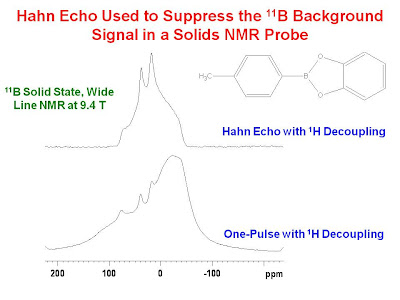Hahn Echo for 11B Background Suppression in Solids
Solids NMR probes often contain boron rich parts near the coil in which the sample resides. Boron nitride, in particular, is a material very commonly used. This can be very problematic if one wishes to collect 11B NMR data, in that a strong background signal may be observed. Even though these parts are not directly inside the coil with the sample, they do experience a small amount of rf from the coil and the coil does detect a 11B NMR signal from them. One simple way to avoid this problem is to use a Hahn
echo to observe the 11B spectrum. Unlike the sample inside the coil, which experiences the 90° and 180° pulses required for the Hahn echo, the boron rich parts outside of the coil experience pulses of much smaller flip angles and therefore the echo signal from them is much reduced. This is illustrated in the figure below, which shows 11B NMR spectra collected in a 4 mm MAS probe without
magic angle spinning. In the lower trace a simple one-pulse measurement was made with high power 1H decoupling. The spectrum contains a very large background signal and it is very difficult to extract any useful information from the data. The spectrum in the upper trace was collected with a Hahn echo with high power 1H decoupling during the acquisition. The background signal is completely removed revealing a beautiful, information-rich line shape for the central transition resulting from the
second order quadrupolar and chemical shielding anisotropy interactions.

Thank you to Joseph Weiss of
David Bryce's laboratory for providing the sample and collecting the data. See more of Joseph's beautiful 11B spectra here:
Joseph W.E. Weiss and David L. Bryce
J. Phys. Chem. 114 (2010) ASAP.
http://dx.doi.org/10.1021/jp101416k



Source:
University of Ottawa NMR Facility Blog



